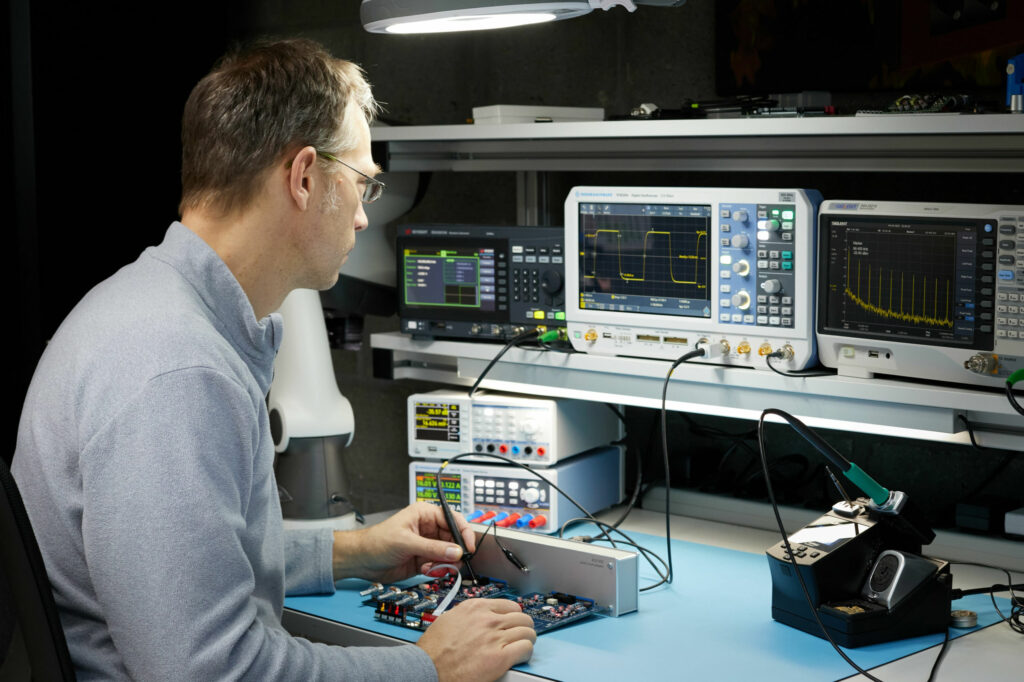
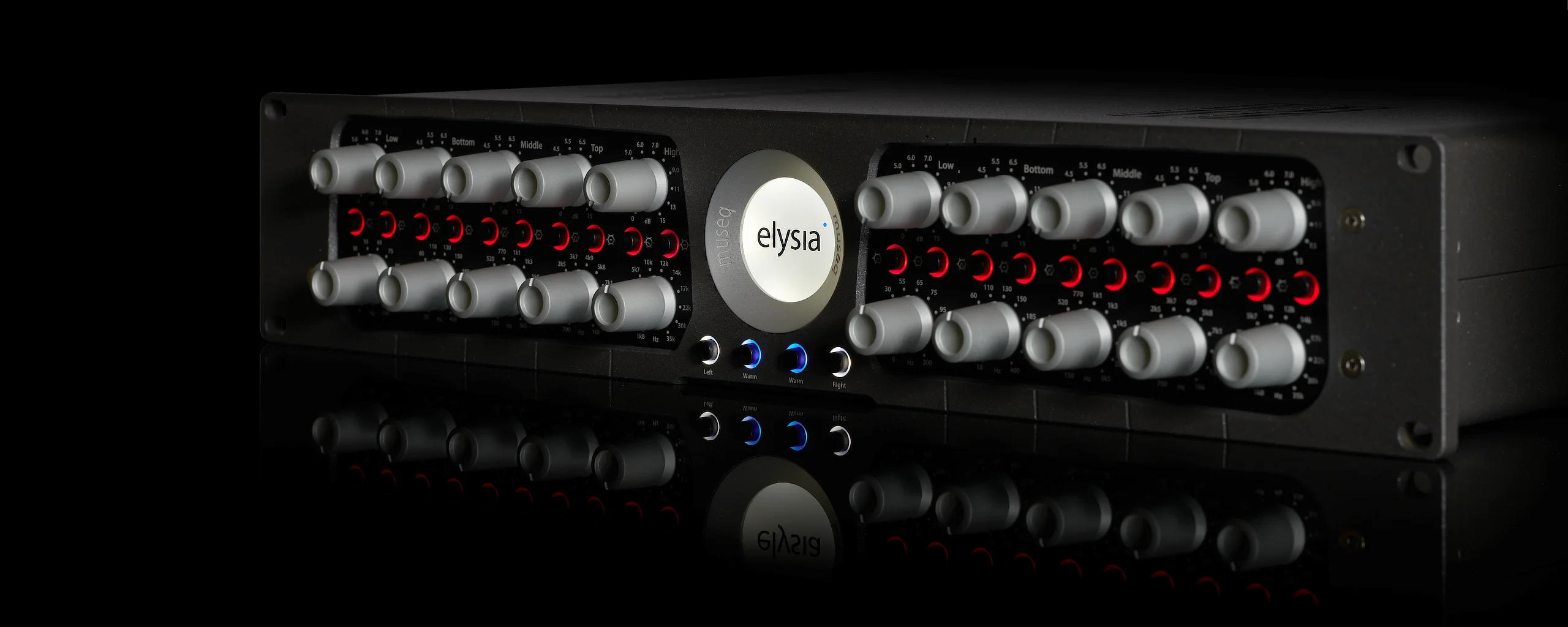

By loading the video, you agree to YouTube's privacy policy.
Learn more

By loading the video, you agree to YouTube's privacy policy.
Learn more
museq can give the final touch to your mastering-grade sound!
Choose between different examples including applications like recording, mixing or even mastering, use good headphones or speakers. Just press Play and A/B between the bypassed and active sounds!
Note: All audio is being processed by the analog hardware device.
Featured artists in these examples: Schutzschall
Note: If you have technical difficulties and don't hear audio playing back, you may want to switch off silent mode on your mobile device.
All filter stages of museq are active designs without any inductors. The actual layout of the bandpasses is where the magic happens: Basically, they are composed of only six transistors, two capacitors and the resistor that determines the frequency.
This circuitry forms a bandpass that operates without any feedback, which results in a very musical sound. Especially regarding filters this puristic and compact design is of considerable acoustic benefit.
Another specialty is the design of the high and low pass filters: in actual fact, the high pass with resonance is a low pass with resonance which is flipped in its phase and then mixed with the original signal.
This has the great advantage that the mid and high frequencies are not affected by the filter and therefore do not change in sound at all. Only the bass frequency region is processed by the filter and the entire signal remains open and transparent.
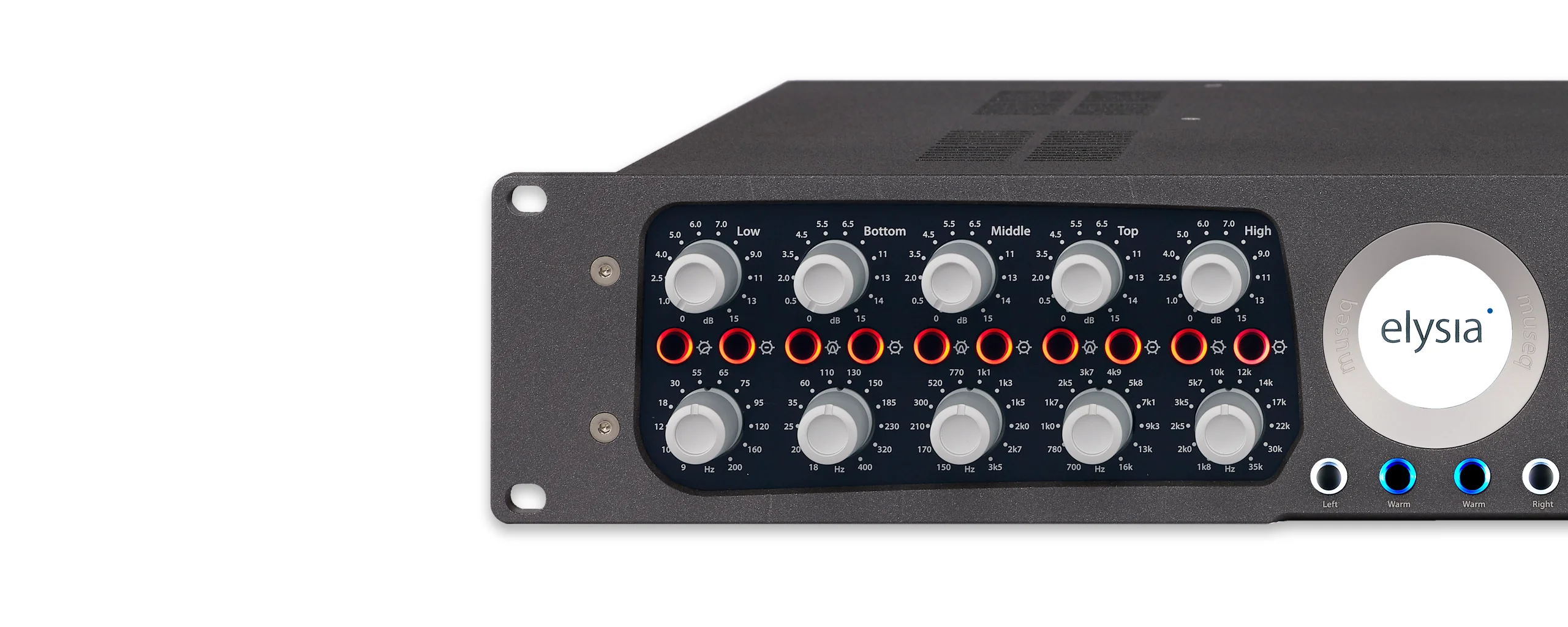
The outer bands of museq show a great amount of flexibility. In their standard mode, they are set up as sweet sounding high and low shelf filters that can be used to tailor the airiness and fundamentals of your tracks fast and efficiently.
As a special feature, you can independently switch these to become high and low cut filters with 12 dB per octave and an additional resonance peak at the knee frequency. This allows some very interesting and useful filter curves.
Especially bass frequencies can benefit from a low cut with resonance by obtaining a clean and punchy character.
This function is basically a slew rate limiter that reduces the speed of the output amplifier stages. This affects the frequency spectrum, the harmonics and the transient response at the same time.
Fast transients are slowed down a bit and the overall sound appears more round and merged. As this function influences the behavior of the output stages, the effect it creates has an impact on the complete processing results of all EQ stages.
In this way museq offers two different sound characters at the push of a button: The powerful transparency of the discrete class-A circuitry and the saturated richness of the Warm mode.
Each band of museq can be switched from boost into cut mode. The advantage is that the complete controller range is utilized for the desired action and the resolution of the stepped potentiometers is twice as large.
Another noteworthy fact is that the filters carry a signal permanently, which grants a superb signal to noise ratio and also produces a pleasant amount of harmonics.
Not until the gain controller is used, the specific frequency band will come into action. If the gain controller remains in its 0 position, the signal will not be affected at all – the band is virtually switched off.
The filter quality of the three parametric bands can be switched between two characteristics: wide (Q 0.5) and narrow (Q 1.3). This does not have any effect on the maximum amplitude.
The filters are based on the constant Q principle, which provides an ever constant filter quality that is independent from the gain controller.
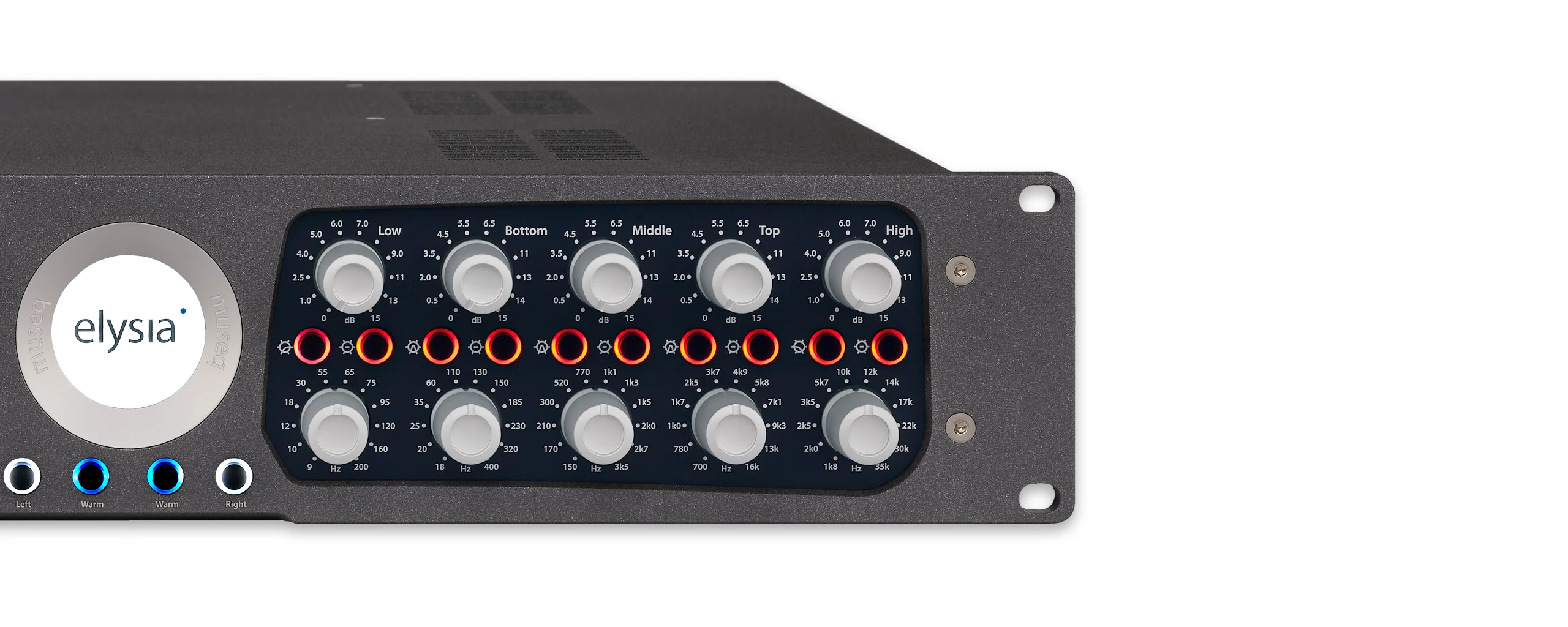
All active stages of museq are based on current feedback amplifiers which have been optimized for a top notch impulse response. These amplifier stages operate completely without the use of additional capacitors.
These caps are usually inserted to eliminate high frequency oscillation (at the cost of affecting the frequency response). The result of consequently not using this kind of capacitors at all is an amplifier which sounds natural, open, dynamic and transparent.
museq features stepped conductive plastic potentiometers for all its parameters throughout. The 21 steps make a precise recall very easy, which is very convenient not only for mastering purposes.
In order to keep the component tolerance as low as possible, we measure all potentiometers and match them as stereo pairs with a software routine we have written exactly for this purpose. The obvious benefit of this effort is that the left and the right channel behave exactly the same.
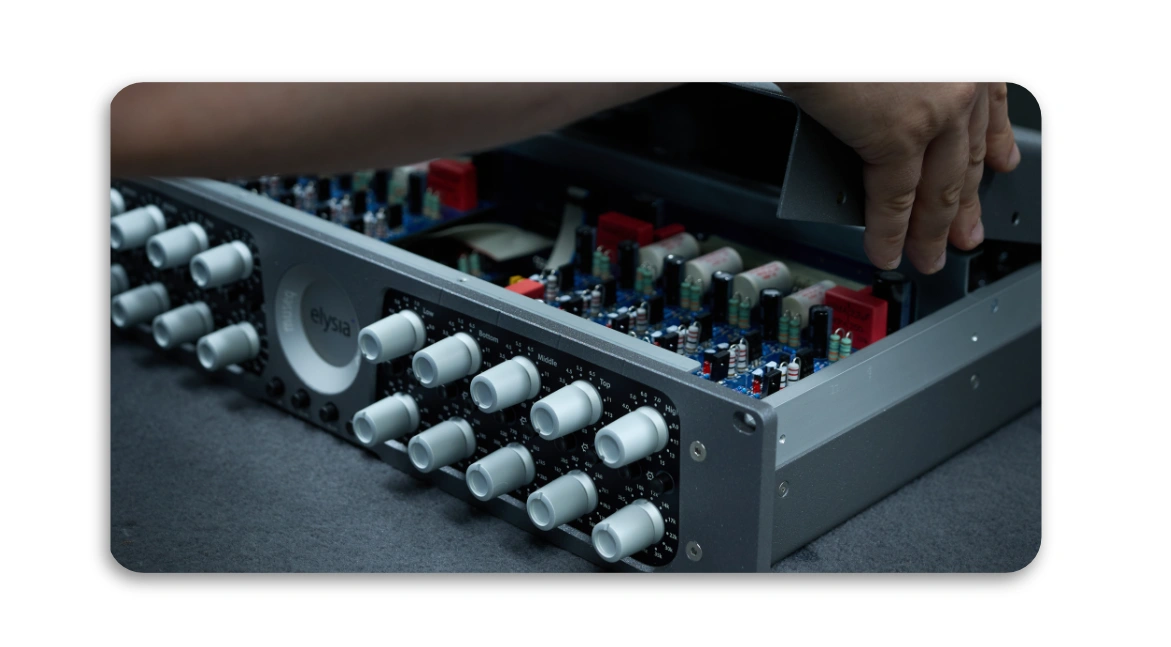
The museq plugin license includes two separate versions optimized for specific tasks. This way, you can always choose the user interface that just works best for you.
The master version adds some powerful extras to the original hardware design, like the integrated M/S matrix for mid and side processing, the possibility to link both channels for more convenient stereo operation, and dedicated output level controllers for adapting your settings to the available headroom.
In addition to this master version with all the bells and whistles, a streamlined mix version with a reduced user interface taking less screen estate is included.

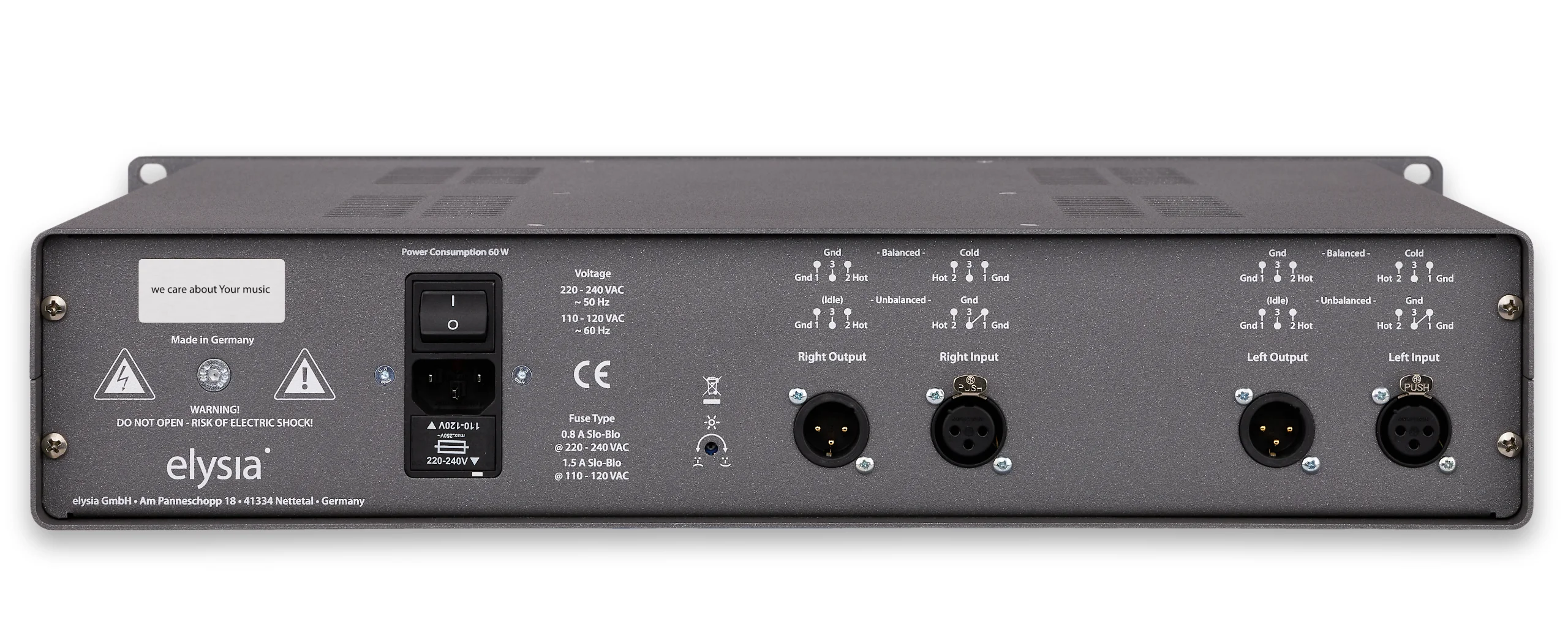
Connecting to museq is easy. As a true stereo device, there are main XLR inputs and outputs for the left and right channel with a handy Pin-out pattern for balanced and unbalanced cables.
A small but useful detail is the built-in brightness control for the logo illumination on the front panel
The mains module combines the line cord connector, the on/off switch, the fuse holder with integrated 230/115 VAC voltage selector and a line filter for providing the transformer with clean current.
Frequency response:
9 Hz – 200 kHz (-0,2 dB)
Low Band frequency range:
Shelf Filter (+/-15 dB):
Cut Filter:
9 Hz – 200 Hz
9 Hz – 200 Hz
Bottom Band frequency range:
Peak Filter (+/- 15 dB):
Quality Factor (Q):
18 Hz – 400 Hz
1,3 (narrow)
0,5 (wide)
Middle Band frequency range:
Peak Filter (+/- 15 dB):
Quality Factor (Q):
150 Hz – 3,5 kHz
1,3 (narrow)
0,5 (wide)
Top Band frequency range:
Peak Filter (+/- 15 dB):
Quality Factor (Q):
700Hz – 16 kHz
1,3 (narrow)
0,5 (wide)
High Band frequency range:
Shelf Filter (+/-15 dB):
Cut Filter:
1,8 kHz – 35 kHz
1,8 kHz – 35 kHz
THD+N @ 0 dBu, 20 Hz – 22 kHz:
0,0037 %
THD+N @ +10 dBu, 20 Hz – 22 kHz:
0,0038 %
Noise floor, 20 Hz – 22 kHz (A-weighted):
-91,6 dBu
Dynamic range, 20 Hz – 22 kHz:
119 dB
Level:
Input:
Output:
+27 dBu
+27 dBu
Impedance:
Input:
Output:
10 kOhm
68 Ohm
Dimensions (W x H x D, incl. Knobs):
19“ x 3,6“ x 15“
483 mm x 90 mm x 380 mm
Weight:
17,2 lbs / 7,8 kg
Power consumption:
46 Watts (60 W max.)
Potentiometers
21 Steps
Precision meets artistry: With the elysia museq, precision and artistry unite in perfect harmony. Its unparalleled filtering capabilities allow you to delicately shape each element of your mix, giving your tracks an unmistakable professional sheen. From subtle adjustments to bold tonal sculpting, museq delivers an exceptional level of control over your sound.
A masterful touch for mastering: Step into the realm of mastering excellence with the elysia museq. Tailored with mastering engineers in mind, it offers an array of features designed to achieve stunningly balanced audio. Experience pristine tonal clarity, precise stereo imaging, and meticulous dynamic control, ensuring your final masters stand tall amidst the competition.
With endless creative possibilities you can fuel your imagination with museq’s boundless creative potential.
museq is designed for intuitive ease of use, making your mixing and mastering sessions an effortless joy. Navigate effortlessly through its user-friendly controls and access the perfect EQ settings in an instant, enabling you to stay focused on the creative process.
Trusted by industry professionals, admired by artists – museq enjoys the trust of audio professionals around the world, earning a spot in the most prestigious studios and the hearts of top artists. Its transparent sound and impeccable performance have contributed to countless chart-toppers and award-winning albums.
Copyright @ 2024 elysia GmbH. All rights reserved. Am Panneschopp 18 | 41334 Nettetal | business hours from monday until friday from 9:00 to 17:00h (CET)
We need your consent before you can continue on our website. If you are under 16 and wish to give consent to optional services, you must ask your legal guardians for permission. We use cookies and other technologies on our website. Some of them are essential, while others help us to improve this website and your experience. Personal data may be processed (e.g. IP addresses), for example for personalized ads and content or ad and content measurement. You can find more information about the use of your data in our privacy policy. You can revoke or adjust your selection at any time under Settings.
If you are under 16 and wish to give consent to optional services, you must ask your legal guardians for permission. We use cookies and other technologies on our website. Some of them are essential, while others help us to improve this website and your experience. Personal data may be processed (e.g. IP addresses), for example for personalized ads and content or ad and content measurement. You can find more information about the use of your data in our privacy policy. Here you will find an overview of all cookies used. You can give your consent to whole categories or display further information and select certain cookies.